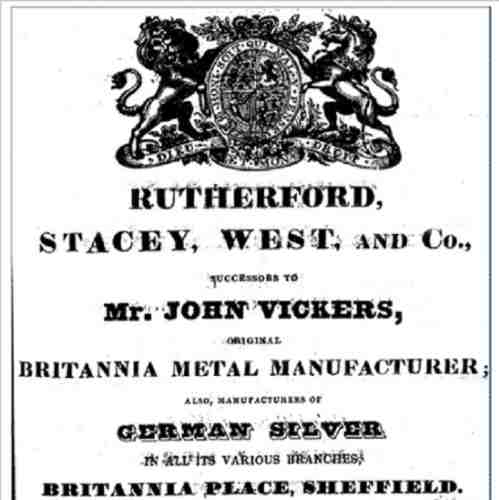|
BRITANNIA METAL
Pewter is known to have been used in Britain since the Roman occupation. Little is known about its use until the Middle Ages when pewter began to appear on the church altar and on the table of the nobility.
With the progression of years pewter became available for other social classes, gradually replacing their wooden eating and drinking vessels.
In 18th century the use of silver continued to be restricted to the nobles and the desire of the working class for better things created a new market which was satisfied by two closely related Sheffield industries: the making of Sheffield Plate and Britannia wares.
The method of plating silver on copper (now known as Old Sheffield Plate) was discovered in 1743 by Thomas Boulsover and by 1750 the Sheffield Plate industry grew and flourished for one hundred years.
The middle class also looked for a product which would add a touch of elegance to their home life. This economic market was one factor which prepared the way for the Britannia metal industry. Unfortunately the long established pewterers were unable to supply the need for elaborate tea services and tableware at modest cost.
|

The pewter industry had been reduces to the limited production of plates, tankards and measures as the concept of pewter making had always been exclusively one of casting and the investment in very expensive new moulds for new products was too speculative for a declining industry.
Moreover the casting process obtained thick and heavy product not in line with the feeling of elegance requested by the market.
The solution was found in 1769 in Sheffield by James Vickers who created the "Vickers White Metal" alloy where the composition was approximately 92% tin, 6% antimony, and 2% copper. The "White Metal" was suited for rolling into sheets stock and could easily utilise resources, knowledge, work skills, rolling mills, stamps, dies, engravers and techniques already available in Sheffield for silver and plated trades.
In 17th and 18th century pewter was also known in London as "French pewter". The political climate and the anti-French feeling during the later part of the 18th century suggested to Sheffield crafters to offer and describe their wares under the more patriotic name of Britannia metal.
The manufacture of Britannia metal remained exclusively in Sheffield (in 1814. fifteen Britannia makers were active) until the first decade of the 19th century when production of the metal began also in Birmingham.
The Britannia metal industry grew hand by hand with the plated trade and by 1825 nearly everything of a domestic nature made in Sheffield Plate was also made in Britannia metal.
The electroplating process introduced in the 1840s by Elkington was welcomed by Britannia metal manufacturers, who well accepted the concept of electroplating as a new business occasion. The original purpose of Britannia metal had been to provide a cheap substitute for silver and Sheffield Plate and the electroplating process brought them closer to their intent. Britannia metal plated well and no change in the production was required other than adding the plating process.
By 1850 electroplating signed the finish of the Sheffield Plate industry and the growth and expansion of the market for electroplate and Britannia metal manufacturers.
By the 1870s Britannia metal slipped into a slow but steady decline as the plated trade replaced more and more of the market and Britannia metal simply went out of vogue.
In an effort to maintain prices competitive, many firms cheapened their product.
This was particularly true for makers who sold unmarked goods, who often made cheap electroplated items with lead handles, feet and knobs and a very light coating of silver.
Many thousands of low quality objects were put on the market in the period 1880-1914 under the mark E.P.B.M. (Electro Plated Britannia Metal), but, in fact, most of the examples which have been thrust forward as being undesirable Britannia metal can be traced back to the electroplate trade.
The production of unplated Britannia metal maintained their quality, but steadily declined in production until 1914.
The "pewter" used as a medium in the production of vases, bowls, personal items, jewellery in the Art Nouveau period was, in most instances, Britannia metal.
|

www.silvercollection.it |
This is a page of 'The What is? Silver Dictionary' of A Small Collection of
Antique Silver and Objects of vertu, a 1500 pages richly illustrated website offering all you need to know about
antique silver, sterling silver, silverplate, Sheffield plate, electroplate silver,
silverware, flatware, tea services and tea complements, marks and hallmarks, articles,
books, auction catalogs, famous silversmiths (Tiffany, Gorham, Jensen, Elkington),
history, oddities ...
HOME - SITE MAP - SILVER DICTIONARY - COOKIES CONSENT AND PRIVACY |
| |